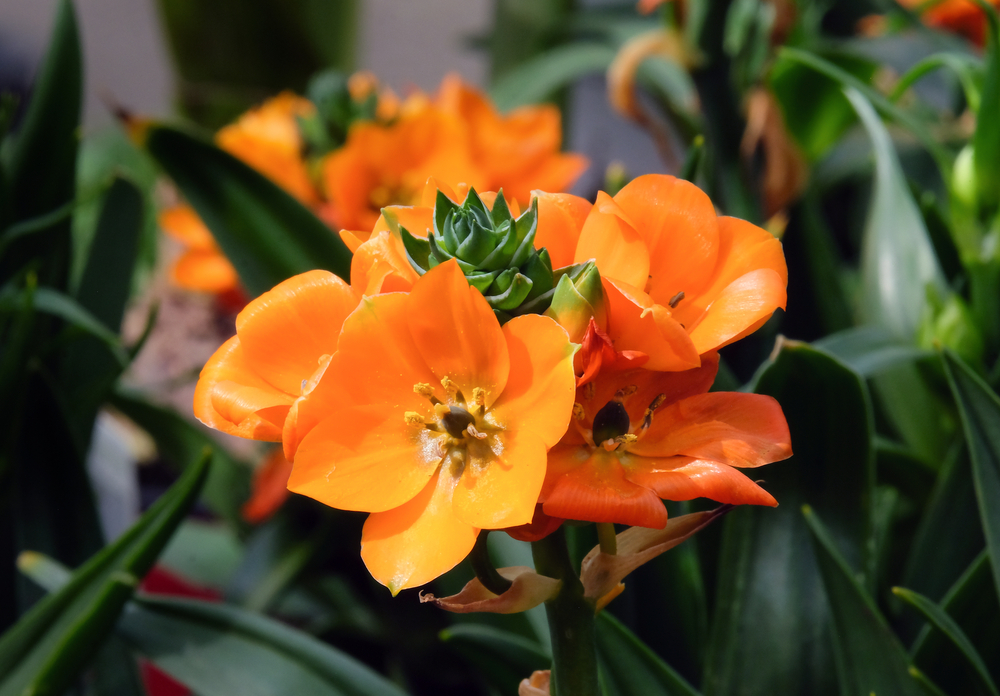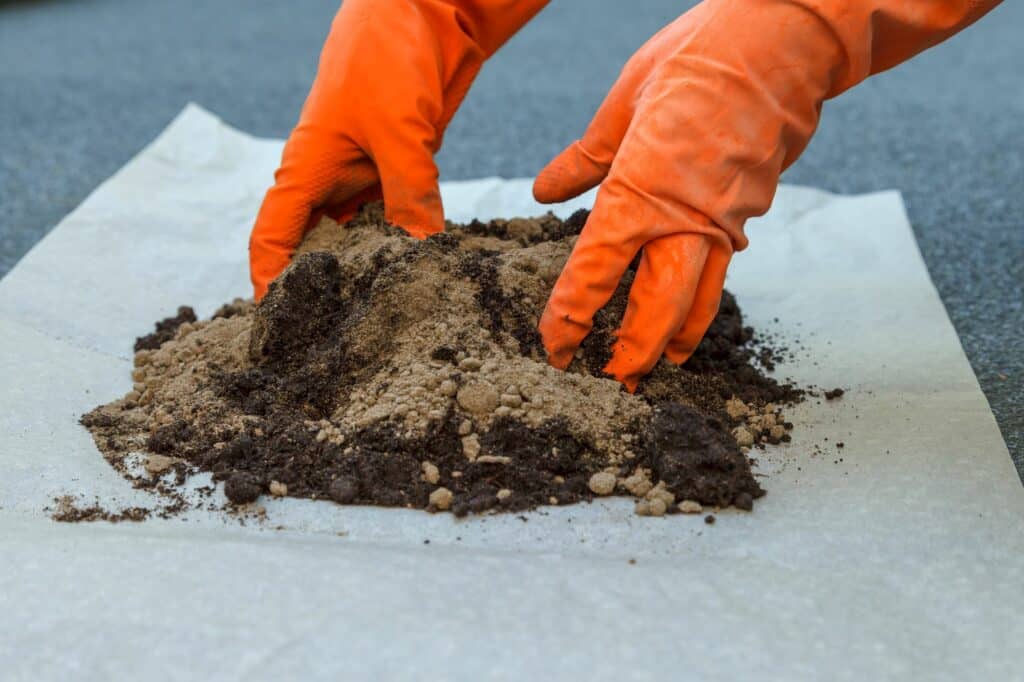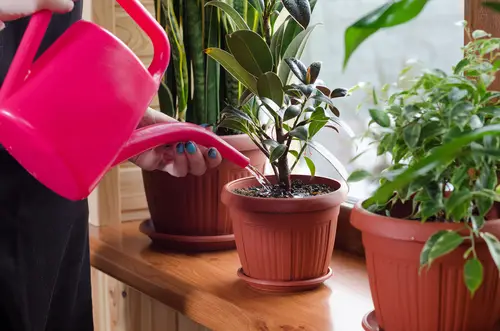Orange star plants are a popular choice for gardeners and indoor plant enthusiasts alike due to their vibrant orange flowers and easy care requirements.
However, drooping leaves can be a common issue for orange star plants, and it’s important to understand the potential causes and solutions to ensure the plant’s health and longevity.
One possible reason for your orange star plant drooping is lack of water. Underwatering the plant can cause the leaves to wilt and droop, while overwatering can lead to root rot and other issues.
Another possible cause is a small or inadequate pot, which can restrict the plant’s growth and lead to root-bound conditions. Additionally, poor soil quality or lack of nutrients can also contribute to drooping leaves in an orange star plant.
Overall, understanding the potential issues and solutions for drooping orange star plants can help ensure the plant’s health and vibrancy.
By providing proper care, including adequate watering, appropriate pot size and soil quality, and regular fertilization, gardeners and indoor plant enthusiasts can enjoy the beauty of the orange star plant for years to come.
Key Takeaways on Orange Star Plant Drooping
- Drooping leaves in an orange star plant can be caused by a variety of factors, including lack of water, small or inadequate pot size, and poor soil quality.
- Proper care, including adequate watering, appropriate pot size and soil quality, and regular fertilization, can help prevent drooping leaves and ensure the plant’s health and vibrancy.
- Understanding the potential issues and solutions for drooping orange star plants is key to maintaining the plant’s health and longevity.
Also don’t miss:
Understanding Orange Star Plant

Origin and Identification
Orange Star Plant, also known as Sun Star, is a flowering plant native to South Africa. It is a bulbous plant that grows up to 18 inches tall and produces clusters of bright orange flowers. The plant prefers full sun and well-draining soil.
The Orange Star Plant is a member of the Asparagaceae family and is scientifically known as Ornithogalum dubium. It is a popular ornamental plant in many parts of the world due to its vibrant and colorful flowers.
The plant is easy to identify due to its unique characteristics. The leaves are narrow and strap-like, and the flowers grow in clusters on tall stems. The flowers are trumpet-shaped and have six petals.
Characteristics
The Orange Star Plant is a hardy plant that thrives in USDA hardiness zones 7 to 11. It is a low-maintenance plant that requires little care once established. The plant prefers full sun and well-draining soil.
The Orange Star Plant is a bulbous plant that grows from a bulb. The bulbs are small and round and produce offsets that can be used to propagate the plant. The plant produces clusters of flowers that bloom in the spring and summer.
The plant is susceptible to root-bound issues, which can cause the plant to droop. It is important to repot the plant every few years to prevent this from happening. Underwatering can also cause the plant to droop, so it is important to water the plant regularly.
In conclusion, the Orange Star Plant is a beautiful and hardy plant that is easy to care for. It is a popular ornamental plant in many parts of the world due to its vibrant and colorful flowers. Understanding the plant’s origin and characteristics can help growers care for the plant and prevent it from drooping.
Caring for an Orange Star Plant
When it comes to caring for an Orange Star Plant, there are a few key factors to keep in mind to ensure that it stays healthy and vibrant. Here are some tips on how to properly care for your Orange Star Plant:
1. Planting Process

When planting an Orange Star Plant, it’s important to choose a container that is the right size for the plant. The container should have drainage holes at the bottom to prevent overwatering.
A well-draining soil mix that includes perlite or peat moss is recommended to help prevent waterlogging. Sandy soil is also a good option for Orange Star Plants.
2. Watering Requirements
Proper watering is crucial for the health of an Orange Star Plant. Overwatering can lead to root rot, while underwatering can cause the plant to wilt and droop. It’s important to keep the soil moist but not overly wet.
A good rule of thumb is to water the plant thoroughly when the top inch of soil is dry to the touch. During the growing season in spring and summer, the plant may need more frequent watering than in the fall and winter.
3. Sunlight and Temperature
Orange Star Plants thrive in direct sunlight, but they can also tolerate partial shade. The ideal temperature range for these plants is between 60°F and 80°F. They are hardy in zones 7 to 11.
4. Fertilization Needs
Fertilizing an Orange Star Plant can help it grow and bloom more vigorously. A liquid fertilizer can be applied every two to three weeks during the growing season. It’s important not to over-fertilize, as this can lead to salt buildup in the soil. A well-draining soil mix can help prevent this issue.
Orange Star Plant Drooping – 4 Common Problems

Orange star plants are a popular choice for gardeners due to their bright orange flowers and attractive foliage. However, these plants can sometimes experience issues that cause them to droop or wilt. Here are some potential issues and solutions to help keep your orange star plant healthy.
1. Common Diseases
Orange star plants can be susceptible to various fungal diseases, such as root rot and powdery mildew. These diseases can cause the plant to droop and wilt.
To prevent fungal diseases, ensure that the plant is not overwatered and has good drainage. If the plant is infected with a fungal disease, remove any infected leaves or stems and treat with a fungicide.
2. Pest Infestations
Orange star plants can attract various pests, such as mealybugs, spider mites, and scales. These pests can cause the plant to droop and wilt. To prevent pest infestations, regularly inspect the plant for signs of pests and treat with neem oil or insecticidal soap if necessary.
3. Drooping and Wilting
If an orange star plant is drooping or wilting, it may be due to improper watering or rootbound issues. Ensure that the plant is not underwatered or overwatered and has good drainage. If the plant is rootbound, repot into a larger pot with fresh soil.
4. Other Issues
Orange star plants can also experience growth issues if they are not receiving enough sunlight or if they are planted in soil that is not suitable for their needs.
Additionally, if the plant is exposed to toxic substances or improper care, it may begin to droop or wilt. Ensure that the plant is planted in well-draining soil and is receiving adequate sunlight. Propagate the plant if necessary to ensure its continued survival.
Propagation and Repotting

Orange star plants are easy to propagate and repot, making them a popular choice for houseplants and outdoor gardens. Proper propagation and repotting techniques can help prevent drooping and keep the plant healthy.
Seed Propagation
Orange star plants can be propagated from seeds, which can be collected from the plant’s seed pods. To propagate from seeds, the seeds should be planted in a well-draining potting mix in a pot with good drainage. The pot should be kept in indirect sunlight and the soil kept moist but not waterlogged. The seeds should germinate in about two weeks.
Offset Propagation
Orange star plants can also be propagated from offsets, which are small plantlets that grow from the parent plant’s bulb. To propagate from offsets, the offset should be removed from the parent plant and planted in a well-draining potting mix in a pot with good drainage.
The pot should be kept in indirect sunlight and the soil kept moist but not waterlogged. The offset should develop roots in about two weeks.
When repotting orange star plants, it is important to use a pot with good drainage to prevent root rot. The potting mix should be well-draining and sandy to prevent the soil from becoming too compacted. If the plant is rootbound, it should be repotted into a larger pot with fresh potting soil.
Orange star plants should be watered when the soil is dry to the touch, but care should be taken not to overwater the plant. Overwatering can cause the plant to droop and may lead to root rot. The plant should be kept in indirect sunlight and should be fertilized every four to six weeks with a diluted fertilizer.
Special Tips for Indoor Orange Star Plants
Orange Star Plants are a great addition to any indoor garden. They are easy to care for and can add a pop of color to any room. However, like any plant, they can experience problems, including drooping leaves. Here are some special tips for caring for indoor Orange Star Plants to keep them healthy and vibrant.
1. Bright, Indirect Sunlight
Orange Star Plants thrive in bright, indirect sunlight. They should be placed near a window that receives plenty of light, but not direct sunlight. Direct sunlight can scorch the leaves and cause them to droop. If the plant is not receiving enough light, it may also cause the leaves to droop. In this case, move the plant to a brighter location.
2. Proper Watering

Proper watering is essential for the health of an Orange Star Plant. Overwatering or underwatering can cause the leaves to droop. The plant should be watered when the top inch of soil is dry. Water the plant until the water drains out of the bottom of the pot. Avoid leaving the plant in standing water, as this can cause root rot.
3. Pamper Your Plant
Orange Star Plants respond well to a little pampering. They enjoy a humid environment, so misting the leaves with water can help keep them healthy. They also benefit from occasional fertilization. Use a high potassium fertilizer every two weeks during the growing season to keep the plant healthy and vibrant.
Conclusion
Drooping in Orange Star plants can be caused by several factors, including root-bound issues, over or under-watering, and lack of sunlight. These factors can be easily remedied by repotting the plant, adjusting watering schedules, and providing adequate sunlight.
It is important to note that Orange Star plants are known for their vigorous growth and can become root-bound quickly. Therefore, repotting the plant every 1-2 years is recommended to ensure healthy growth.
Additionally, Orange Star plants can benefit from regular fertilization, especially during the growing season. A balanced fertilizer with equal amounts of nitrogen, phosphorus, and potassium can be applied every 2-3 weeks to promote healthy growth and vibrant blooms.
While Orange Star plants are relatively easy to care for, they do require some attention and love to thrive. With proper care, these plants can be a beautiful addition to any garden or home.
It is also worth noting that Orange Star plants are not the same as Hibiscus plants, although they may look similar. Orange Star plants are part of the Ornithogalum genus, while Hibiscus plants are part of the Malvaceae family. Therefore, care instructions and requirements may differ between the two.
Lastly, for those interested in purchasing Orange Star plants, they can typically be found for sale at nurseries or online plant retailers. It is important to research the seller and read reviews before making a purchase to ensure quality and healthy plants.
Frequently Asked Questions
How do I revive a drooping orange star plant?
If your orange star plant is drooping, it may be due to overwatering, underwatering, or rootbound issues. To revive a drooping orange star plant, you should first check its soil moisture level, and adjust your watering schedule accordingly.
If the soil is too dry, water the plant thoroughly. If the soil is too wet, let it dry out before watering again. Repotting the plant may also help if it is rootbound.
What are the common causes of orange star plant drooping?
The most common causes of orange star plant drooping are overwatering, underwatering, rootbound issues, and lack of sunlight. Overwatering can lead to root rot, while underwatering can cause the plant to wilt.
If the plant is rootbound, its roots may be too dense and unable to absorb water and nutrients properly. Lack of sunlight can also cause the plant to droop.
How much water does an orange star plant need?
Orange star plants prefer to be kept moist but not waterlogged. They should be watered when the top inch of soil feels dry to the touch. The amount of water needed will depend on factors such as the plant’s size, the temperature, and humidity levels in the environment.
What is the best way to care for an indoor orange star plant?
To care for an indoor orange star plant, provide it with bright, indirect sunlight, and keep the soil moist but not waterlogged. Fertilize the plant with a balanced fertilizer once a month during the growing season. Repot the plant every two to three years to prevent it from becoming rootbound.
Are orange star plants poisonous to pets?
Orange star plants are toxic to pets, including dogs and cats. The plant contains lycorine, which can cause vomiting, diarrhea, and other gastrointestinal symptoms if ingested. Keep the plant out of reach of pets and children.
How do I prevent yellowing leaves on my orange star plant?
Yellowing leaves on an orange star plant can be a sign of overwatering, underwatering, or nutrient deficiencies. To prevent yellowing leaves, make sure the plant is not being overwatered or underwatered. Fertilize the plant with a balanced fertilizer once a month during the growing season to provide it with the nutrients it needs.

Hey, I’m Lisa and I’ve been an avid gardener for over 30 years. I love writing, talking and living in the garden! Feel free to connect with me on my socials below


